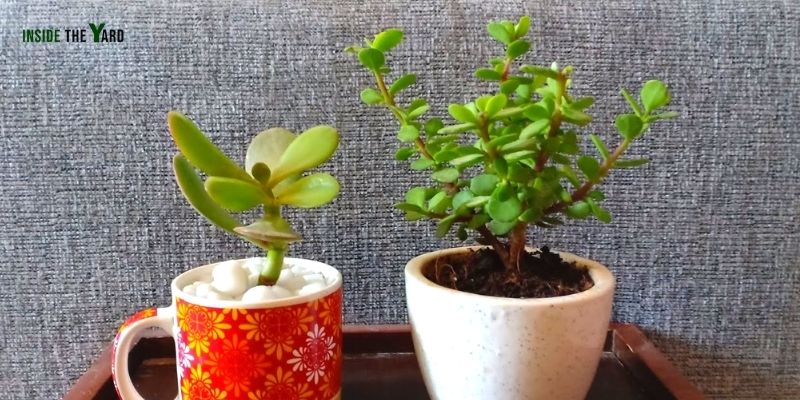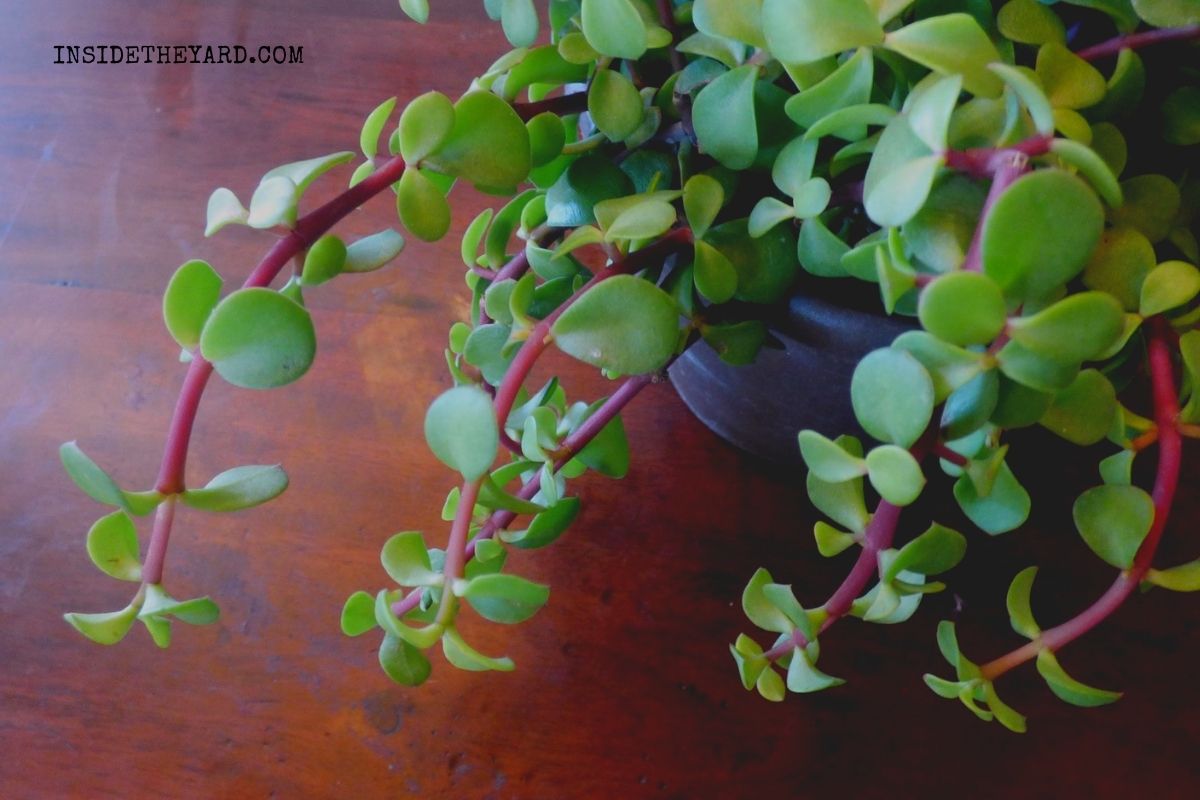
Do jade plants and elephant bushes have any differences or are they the same? Well, the very first difference you may notice between these two plants is their growth habits. The jade plants often grow upright, whereas the elephant bush branches droop until new rigid leaves or plants grow.
Alongside the growth habits, a few things make them quite different; this includes significance, growing conditions, benefits, and many more. So our elephant bush vs jade plant comparison will explore some more differences, for which you can choose the one you’re searching for.
Elephant Bush Vs Jade Plant- Comparing Two Plant King
| Key Points | Jade Plants | Elephant Bush |
| Growth Habit | Can grow between 3 to 6 feet | In natural habitat up to 20 feet But at home, it grows up to 2-5 feet. |
| Leaf | Waxy, thick, oval-shaped | Soft, thin, rounded |
| Growing Conditions | Grows best at 18° to 20° C | Grows best in the full sun or warm environment |
| Lifespan | 70 to 100 years | Over 50 years |
Comparing the Flowers
The elephant bush blooms when they are properly taken care of. They produce white, pink, or purple flowers in their growing conditions. The clustered flowers make a pretty view. So, often at the restaurant or shop entrance, you can see elephant bush.
On the flip side, Jade plants do not bloom so often, especially if kept at home or indoors. But if you move them to a dry location and cooler temperature, they can produce white flowers. The plants need to be aged enough to produce flowers.
Contrast in Benefits
According to Chinese Feng Shui tradition, the Jade plants bring monetary benefits. Also, people have considered these plants to be good luck charms for ages. Therefore, they make an ideal wedding or housewarming gift. They hold the symbolic significance of prosperity, friendship, and positivity.
Jade plants also elevate humidity levels in the environment. Dry air can cause dry and itchy skin, but the plants help fix the environment by keeping the humidity level between 30 to 60 percent.
The Elephant Bush is an ideal food plant for elephants and grazers. Its juicy leaves and stalks provide almost 80% of the diet grazers need. Also, its meaty leaves are one of the popular ingredients used in African food culture. You can use them in your soup or salad to enhance the flavor of your dish.
Also, the Elephant bush is often considered to be a carbon sponge. Because it can suck 4 to 10 tonnes of carbon dioxide from the environment, it makes the air more breathable. Their citrus or lemon-like flavor is a good mood uplifter.
Differences Highlight in Growing Conditions
The elephant bush requires plenty of sunlight and a warm environment to keep from withering. Ideally, 21° to 29° C is the correct temperature to thrive. Every day they need six hours of sunlight to keep the roots and stems strong. But you need to keep them in partial shade for sunbathing. Otherwise, direct sunlight will burn their thin leaves.
Contrarily, Jade plants grow best at a cool temperature, dry conditions, and low humidity. A temperature between 18° to 21° C is ideal for them. Also, they need at least four hours of sunlight daily.
Both the plants require well-draining soil. Because overly moist soil will turn their leaves yellowish or droop. Loose, grainy, rocky soil is best for them as the soil is quick to soak unwanted moisture.
Spotlight on Growth Habit
The Jade plants do not grow rapidly. They grow one to two inches once a year. On the contrary, the elephant bush can grow up to 4 to 6 inches in a year. And it takes 4 to 6 weeks to completely take root.
Moreover, the jade plant leaves grow upright, whereas the elephant bush trail until you prune them. The trails can reach up to 12 inches below the container.
Nurturing Differences
Another noticeable difference between jade plants and elephant bush lies in their general care or nurturing needs. While the former are low-maintenance plants, the latter requires comparatively more care to grow properly.
You do not need to maintain a frequent watering schedule for the jade plants. They are highly drought tolerant as they store water in their leaves. So they will not go dehydrated or wither even if you skip watering them for 3 to 4 weeks.
Before watering the jade plants, you need to make sure the top layer of the soil looks dry enough. Water them thoroughly once every three weeks during the spring and summer seasons. But spray or drizzle water in the fall and winter to prevent overwatering in humid weather.
Elephant bush requires frequent watering once every two weeks. Also, they need proper drainage after you water them. Don’t leave them with water sitting under the container; otherwise, their roots will break or rot. So, keep them in a pot with larger drainage holes.
To prevent elephant bush root overheating, you need to apply soluble fertilizer with compost tea, coir fiber, and fish emulsion. You need to fertilize them once a month. But for jade plants to thrive, liquid fertilizer once every three months is sufficient.
Frequently Asked Questions (FAQs)
How do I identify a Jade plant?
It gets pretty confusing to identify Jade Plants or Crassula Ovata as they are quite similar to Elephant Bush. To recognize a Jade plant, look for the fleshy, dark green, and spoon-shaped leaves. Sometimes the leaf edges look reddish in proper sunlight. You can get a plant identification cheat sheet from any online to identify the plant quickly.
What is the difference between a Jade plant and a money plant?
There is no specific difference. There is a belief that it brings money and prosperity. And with age, the plants develop round and plump leaves that resemble the shape of a coin. So the Jade Plants are famously known as money plants.
Is elephant bush a lucky plant?
No, Elephant Bush is not a lucky plant. People consider the Jade Plants to be lucky. However, Elephant Bush and Jade Plant look pretty similar. So some people confuse the elephant bush with a lucky plant famous for being the symbol of prosperity. But the use of the elephant bush is widespread in some African cuisine and home decor.
How long will a jade plant live?
Jade plants have a long lifespan. They are low-maintenance plants, so they can live for years even without regular care. But if they get proper sunlight and maintenance, seasons can live for at least 50 to 100 years. Because of their long lifespan, they make an excellent generational gift.
How often should Jade be watered?
There is no specific schedule when it comes to watering a Jade plant. You can water it once every 2 to 3 weeks to keep it from going limp. But you just need to remember not to overwater the plant. And don’t water when the soil is already damp. We recommend you not to water the plants if the humidity is high in the environment.
Which Plant Should You Go For?
It might be a little tiring to look after plants on a regular basis, especially if you have a busy schedule to maintain. In that case, go for a jade plant. Because, unlike the elephant bush, jade plants do not require regular maintenance to thrive.
If you believe in lucky charm and positive energy, you should keep jade plants in your workplace and home. Also, you can gift them at any festival. Because according to Chinese tradition, these plants promote growth, money, and friendship. But for home décor, elephant bush is an elegant choice.
Hopefully, our elephant bush vs jade plant comparison can cast your confusion away about picking your ideal plant. Have a great day ahead!
